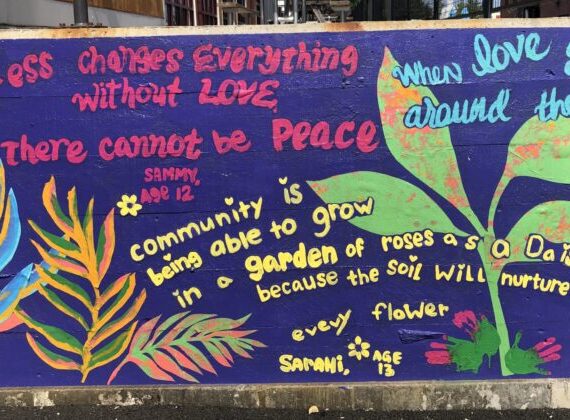
Participants in Saturday’s Quality of Life Community Conversation were told by moderator Alice Leibowitz to “listen to understand” and that “no one needs to promote or defend their opinions,” but old habits die hard. Some people left early, others kvetched about the meeting model, and others ignored the process entirely. Even with resistance, there were residents who moved out of Debbie Downerville and into action.
Previously, residents from what is designated as the “North District” met. This past weekend, Pope Park Rec Center hosted a meeting for those from the “South District.” The “Central District” meeting — for just Downtown, Asylum Hill, and the West End — is scheduled for the last Saturday in September. This Quality of Life Initiative is sponsored by Hartford 2000 in partnership with the City of Hartford, Hartford Police Department, Hartford Public Library, and Metro Hartford Alliance. The meetings are intended to be conversations; these are not “tell ’em why you mad” sessions.
The dialog starts with introductions, then people break into small groups where conversations are prompted by questions. Moving from first impressions of Hartford to images of good neighbors to images of a good neighborhood, participants mixed into different groups, meeting individuals from various neighborhoods that had been lumped together because of how the police department has divided the city.
Even though the South West neighborhood looks extremely different from Frog Hollow or Barry Square, residents across the city had some common positive impressions of Hartford. Diversity, architecture, walkability, and the “small town” feeling of Hartford were named as attractive qualities. In small groups, participants from the “South District” said that a perfect neighborhood is one in which people say “hello” and know each others’ names, where children play outside, and where the streets are clean.
The positive phrasing of these prompts were hard for some to get beyond, as the tendency was to use negations. When it was time to describe what a good neighbor does, people were heard saying “no drugs” and “no loud music,” instead of embracing the idea of positive actions taken by residents. The purpose of the meeting clicked with some residents; not so much with others.
It was early on in these conversations where people were heard complaining that this was “just one more meeting,” not noticing that there were more than the usual suspects attending. The police in attendance actually participated in the discussion instead of remaining stoic wallflowers. State Senator John Fonfara and State Representative Edwin Vargas were both in attendance and participating; State Representative Minnie Gonzalez, who represents the district where this meeting was hosted, was not present. But in this case, the presence of City and State leaders was not especially warranted as the goal of the meeting was to inspire residents to be problem solvers.
This was another roadblock for some. When asked “What is something you could do tomorrow to help improve your neighborhood?,” some participants were heard giving responses that showed either a disconnect or an intentional dodge. The tendency was to place the burden of fixing all problems back onto City or State leaders, or to do nothing more than blame youth for issues that the children themselves have not created.
With members of the Hartford Police Department saying that more police would help, State Senator Fonfara asserted: “we’re never going to police our way out of this problem.”
Hartford resident Carmen Rodriguez, sensing the frustration of those who expected this to be a chance to vent at City leaders, told participants, “Please don’t get discouraged. It takes a lot to keep doing what we’re doing.”
It does. This is especially true when many residents are willing to leave the work to others, or simply do not care to engage.
Eventually, nine or ten action ideas emerged from the discussions, though some of these have already been in motion. A skillshare/skill bank where people can help each other and then “share a drink together” was created by a man named George who came to the United States for political asylum.
State Senator Fonfara helped to create a group that would do outreach, as he said that quality of life issues need “buy-in from people who aren’t here.”
Most of the event’s promotion has been done via Internet; flyers were not seen posted widely in the neighborhoods for this. One of the action groups that merged with Fonfara’s group said it had the goal of creating a central place for information distribution.
One city resident created an action group that would partner “citizens” with City government to make the city better and “more citizen-oriented.” A few other residents had a similar idea and merged with the group, attempting to revive the Comprehensive Community Partnership, an initiative that dates back several decades.
Joe Wasserman and Martha Kelly of Connecticut Coalition for Environmental Justice formed a Reduce, Reuse, Recycle, and Compost Committee, which will be meeting on September 16th. Virginia Iacobucci, who has been working on issues related to landlord responsibility, created an action group that will meet on September 11th.
With the city divided into segments and meeting separately, the possibility for redundant action groups seems great. This could have been resolved by making meetings inclusive of all residents at once.
The “Central District” meeting is scheduled from 10-2 on September 28th at Grace Lutheran Church, 46 Woodland Street. Breakfast and lunch are provided. A Community Get-Together for all participants will be held on October 23rd at 5:30pm in the Hartford Public Library.
